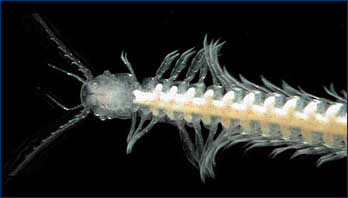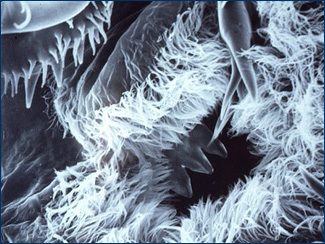
Dorsal view of a remipede from the Bahamas.
Remipedia
 Dorsal view of a remipede from the Bahamas. |
Remipedes, a rare group of marine crustacean first described in 19811, occur only in anchialine karst systems in Central America, the Caribbean, the Canary Islands, and western Australia. Anchialine caves are generally dolomite or limestone in composition and contain a marine layer that flows beneath a fresh or slightly brackish layer.
Morphological and genetic evidence has led many phylogeneticists to classify remipedes as ancestral crustaceans2. However, the well-developed brains and sensory organs of these organisms have convinced other researchers that remipedes stem from more derived lineages3. These disagreements reflect our restricted knowledge of remipede natural and evolutionary history.
The living representatives of this group, of which there are only 17 known species, are the Nectiopoda. Remipede adults feed with three pairs of raptorial mouthparts unique to the group1. Remipede bodies are divided into a cephalon (head) and elongate trunk with up to 32 similarly shaped segments. All known living remipedes except Enantiopoda lack eyes (see next paragraph). The appendages on the trunk segments are paddle-like and directed out to the side. This appendage orientation is unusual in crustaceans, and it makes them superficially similar to polychaete worms (Annelida). Remipedes swim on their backs similar to the Anostraca (fairy shrimp). All known species of the Remipedia are hermaphroditic, simultaneously containing both female and male sexual organs4. Yet, little else is known about their reproductive cycle or their ability to disperse. There remains much to learn about the biology of these unusual animals.
The extinct group of Remipedia are the Enantiopoda, represented by two fossil forms: Tesnusocaris goldichi, described in 19555, and Cryptocaris hootchi6, described in 1991. Tesnusocaris was found in the lower Pennsylvanian Tesnus Formation of Texas. Cryptocaris is from the famous middle Pennsylvanian Mazon Creek faunas of Illinois.
 Mouth area of a typical remipede. |
Resources
Original page created by Ben Waggoner 1995 with further modifications by Amy Lesen 8/2002; updated text content by Joey Pakes and design modification by David Smith 6/2008. Bahamas remipede photo © Dennis Williams and Jill Yager; all other remipede photos © Jill Yager, Antioch College.